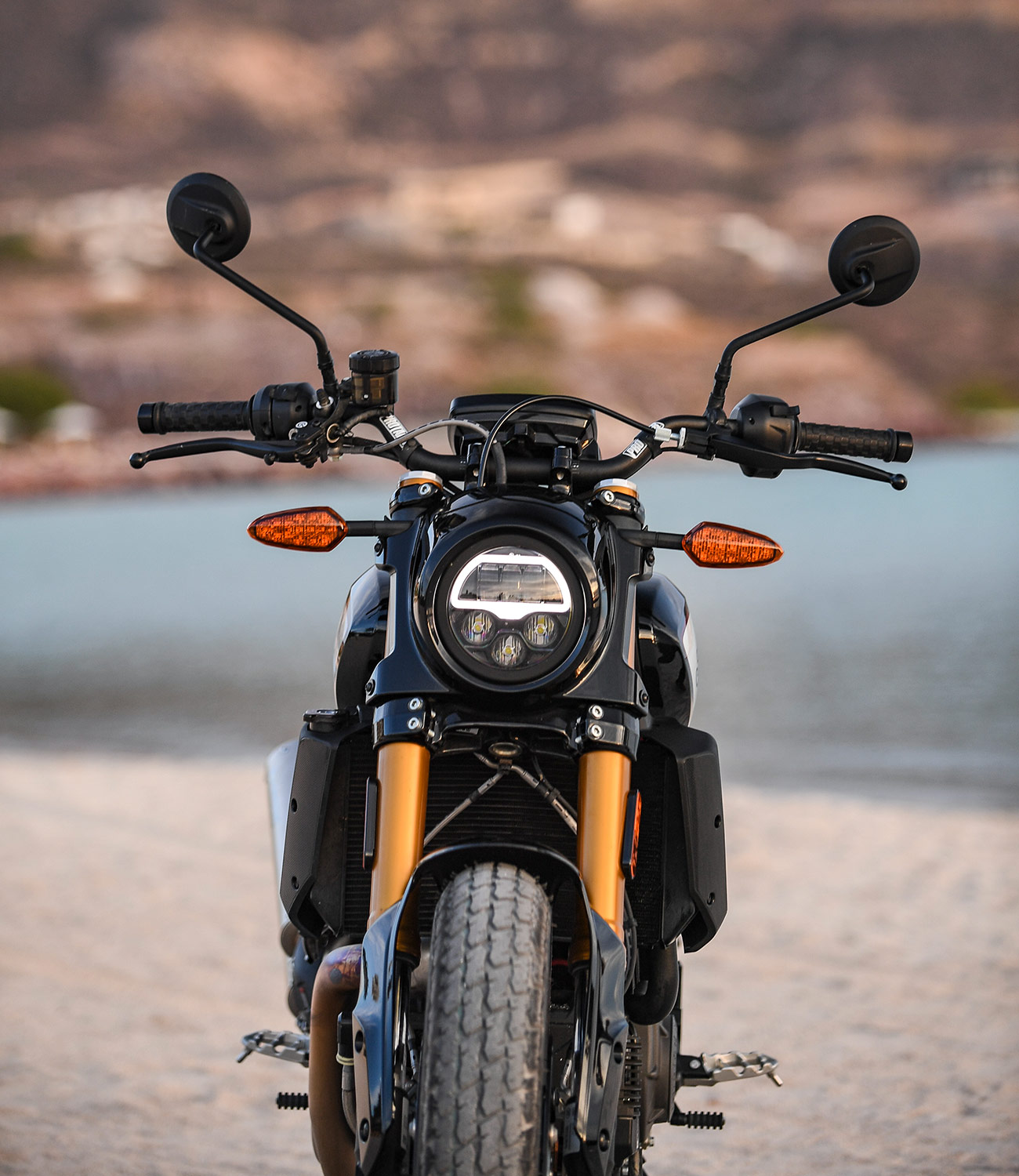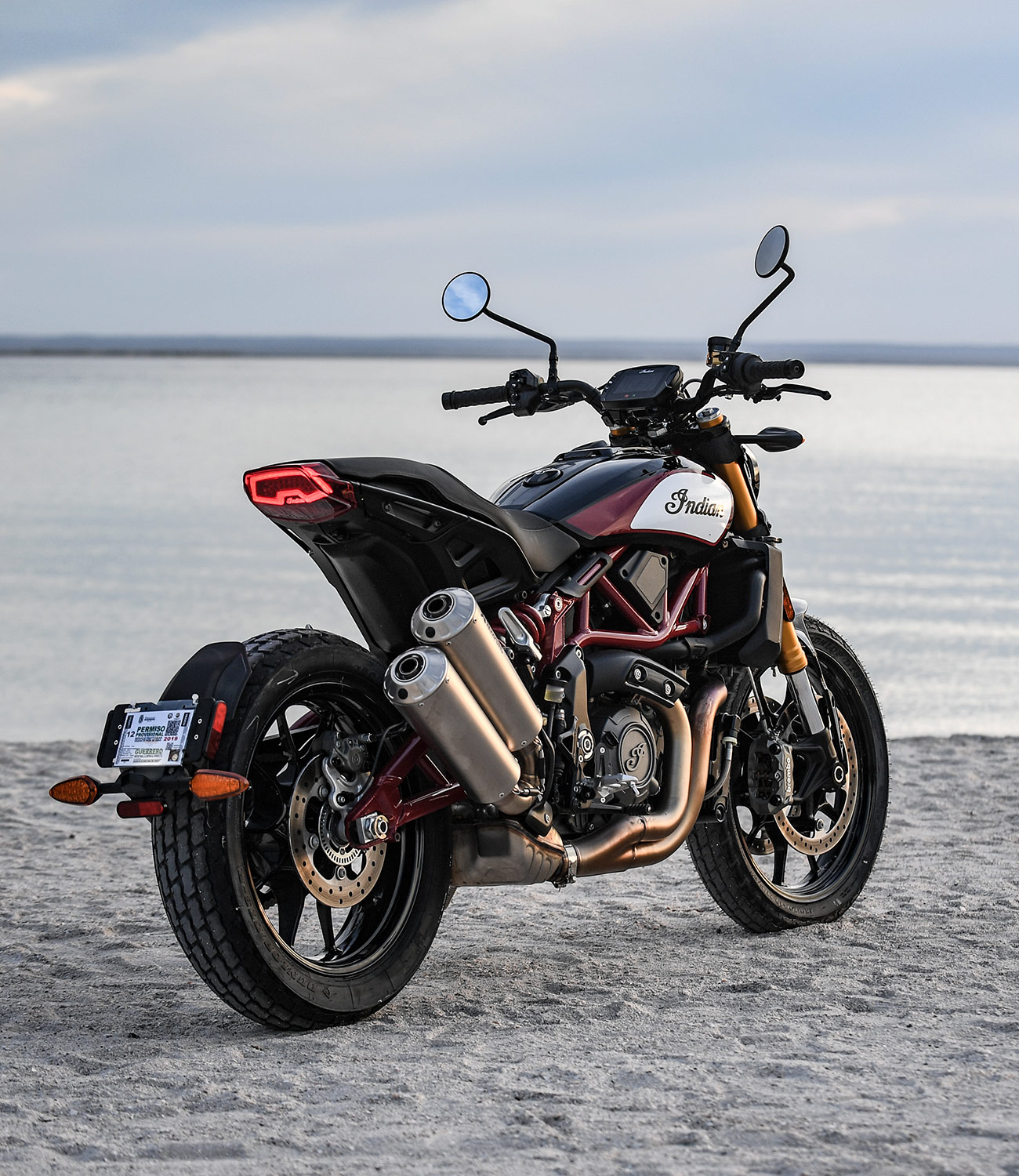Ever since its 2011 resurrection by Polaris Industries, Indian Motorcycles has focused on large, beefy cruisers for the Crosby, Stills and Nash set. But with an aging customer base, it’s only logical that Indian would be looking to grow its appeal — and the much-anticipated FTR 1200 is the Minnesota company’s first concentrated effort at empire expansion. Tapping the American motorcycle brand’s rich history in flat track racing — its infamous Wrecking Crew team claimed championships in the harrowing sport for three consecutive years from 1951 to 1953 — Indian’s new FTR 1200 is based off their FTR750 racing bike. That’s rather appropriate: Indian’s Jared Mees has mirrored the Wrecking Crew’s success by winning back-to-back championships in 2017 and 2018 on the back of a FTR750.
The Good: The FTR 1200 benefits from being Indian’s first clean sheet design in half a decade; it’s a well-engineered machine from headlamp to tailpipes. Indian engines are known for their power, and the FTR 1200’s liquid-cooled 1203-cc V-Twin is no exception; the new configuration optimizes airflow for additional power and torque, enabling it to eclipse competitors like BMW’s R Nine T. The clutch is light and engages the quick-shifting six-speed sequential transmission with ease. And the amount of engineering work spent on optimizing balance and weight distribution is clea from the first time you climb aboard.
Who It’s For: The FTR 1200 was conceived to expand Indian’s reach, with Europe and Japan as major target markets. For this reason, Indian worked closely with its Polaris sister company SwissAuto in developing the bike, to make sure it appealed to European customers whose playgrounds are much different than the roads that burly cruisers like the Chief and Roadmaster call home. Meaning the FTR 1200 has to handle corners; agility, grip and balance are a priority. Moreover, the flat-tracker has to appeal to the aesthetics of a customer who’s cross-shopping bikes like the BMW R Nine T, Triumph Bonneville and Thruxton, and Ducati Scrambler 1100.

Watch Out For: The obvious ding on the FTR 1200 is cost versus its Japanese competitors, but it’s still competitive with the price of European rivals. Other than that, the only weakness I encountered with the FTR 1200 was when I had to ride some 60 miles on dirt connecting several tiny surfing pueblos. There were no paved streets so Indian took us on what they thought would be packed fire roads, only to discover that these gutted paths were littered with patches of deep sand, resulting in several riders dropping their bikes. But, honestly, no one should be taking a nearly 500-pound street bike on deep, dune-like sand. On hard-packed dirt, it should be noted, the bike lived up to its flat track roots just fine.
Alternatives: Ducati Scrambler 1100 ($12,995), Husqvarna 701 Svartpilen ($11,999), BMW R Nine T Scrambler ($12,995)
Review: Indian selected the southern tip of Baja California to show off its latest creation’s merits, and the two-day, 300-odd mile trek’s terrain proved an excellent canvas for the FTR 1200 to showcase its stuff. The roads that connect Cabo San Lucas to La Paz and Todos Santos provide numerous types of riding, which underscored the bike’s versatility. It’s a true polymath, as good taking on the twisties that hugged the mountains as it was humming along at 80 mph on seemingly endless stretches of highway.
“We were lucky in a sense coming into a whole new segment, a whole new platform. We got to step back at an early stage and look at what everybody else has done and try to innovate beyond that,” Indian’s vice president of engineering John Callahan explained over copious fish tacos. “So we were in a good situation — we didn’t have to take something we already had and make an evolutionary product out of it.”

This clean sheet engineering is most apparent in the FTR 1200’s overall architecture, which incorporates the innovative decision to move the gas tank under the seat. Engineers wanted to optimize airflow into the V-Twin, so they configured the airbox directly above the engine where the fuel tank would normally go. This placement accomplishes two things: It improves air flow to the engine to increase power and torque output, and it centralizes the bike’s mass by relocating the tank directly under the rider. Gasoline isn’t light; the placement of the weight of the 3.4-gallon tank lowers the overall center of gravity and contributes to the bike’s excellent balance. (And as the tank empties, the liquid weight funnels further down and towards the middle.)
The FTR 1200’s designer Rich Christoph previously worked with legendary motorcycle engineer Eric Buell, who he says taught him to “design the air out of the bike” — that is, package everything tightly and remove any and all unused space to form a taut, sleek silhouette. This tight packaging within the steel tube trellis frame and aluminum rear subframe contributes to the FTR 1200’s overall sense of structural integrity and balance, as does the S-spec suspension.
With nearly six inches of travel, the gold 43-mm telescopic forks easily absorbed the many dramatic bumps and unexpected dips the Mexican infrastructure served up. The shocks are compliant enough to feel all-day comfortable on the longer, straighter stretches and ably swallow the countless giant speedbumps I encountered, but also sufficiently stable and stiff on the many snaking turns found climbing the Sierra de la Laguna mountain range. Grip is aided by race-inspired DT3-R tires, developed exclusive for the FTR 1200 by Dunlop to secure stickiness European riders demand.
Those turns are also where the V-Twin’s 123 horsepower and 87 pound-feet of torque strut their stuff. Exiting some unexpectedly tight corners, I occasionally found myself a gear too high, yet the engine served up a surfeit of low-end torque in smooth, generous and predictable surges with a light twist of the throttle. You’ll never be lacking for torque, even if you find yourself a couple gears off target.
The 1203-cc powerplant isn’t just a hopped-up Scout engine, either. Engineers say it’s an entirely new engine, with an FTR-specific crankcase, cylinders, heads and all internals. When the time comes to stop, standard Brembo brakes (dual radially mounted 320mm discs with 4-piston calipers up front, single 260mm semi-floating disc with 2-piston caliper in back) with ABS scrubbed speed quickly and controllably.

During long stretches of highway riding, the FTR 1200 never feels tiring. Its wide, cushy padded saddle offers plenty of longitudinal and lateral movement (to prevent your ass from falling asleep), the S-spec cruise control keeps the power flowing, and most importantly, the bike’s upright riding position proves imminently comfortable. Pegs are located directly under your hips, and the wide flat track-styled ProTaper aluminum handlebars are low enough to retain the FTR750’s sexy silhouette but still high enough to remain comfortable during long stretches of straight-line riding.
One caveat for shorter riders: the combination of a high riding position (it has a 33.1-inch seat height) and an extra-wide saddle disqualifies the FTR 1200 for some of the potential conquest customers Indian is trying to woo. Newer riders and smaller women may feel snubbed; some shorter journalists had a tough time touching ground at stops. Compare that with the Ducati Scrambler’s much more accessible 31-inch height, a delta made even more significant when paired with the FTR 1200’s extra-wide seat.
There are enough tech flourishes on the S-spec model to appeal to younger clientele, most obviously the 4.3-inch Ride Command full-color TFT touchscreen display plucked from the Chieftain and Roadmaster. The system makes it easy to toggle between analog-style or modern-looking gauges, engage cruise control, and select between three ride modes (Sport, Standard, Rain) that alter throttle response and traction control intervention. (ABS, stability control and traction control are all lean-angle sensitive.) Bluetooth and a fast-charging USB port allow riders to control their phone and music via the display, as well The base FTR 1200 lacks all the above gadgetry, however, subbing in a four-inch analog gauge cluster; that said, it still offers the USB port, as well as LED lighting.
And last but certainly not least, it should be noted that this is a fine-looking bike. It doesn’t try too hard or look over the top. The trellis frame, 19-inch wheels, seat and profile are all well-proportioned and radiate a sense of sturdiness and simple badassery. (For extra style, tick the box for the optional high- or low-mounted titanium Akrapovic pipes, which not only fill the air with a sonorous roar but lend the FTR 1200 an even better profile.) It’s an American flat tracker reimagined for the streets, and it damn well looks the part.
Verdict: The FTR 1200 will almost certainly succeed in its goals of opening up new markets for Indian. Sure, it’s a looker, which is imperative when going against the Ducatis and Triumphs of the world. But more importantly, its engine, smooth power delivery, and spectacular balance should tick all boxes with demanding European and Japanese buyers — especially those looking for an American bike that delivers on its promises.
2019 Indian FTR 1200 Specs
Powertrain: 1,203-cc V-Twin, six-speed sequential transmission
Horsepower: 123
Torque: 87 pound-feet
Lean Angle: 43 degrees
Weight: 488 pounds (empty)
Indian hosted us and provided this product for review.

Hot takes and in-depth reviews on noteworthy, relevant and interesting products. Read the Story

